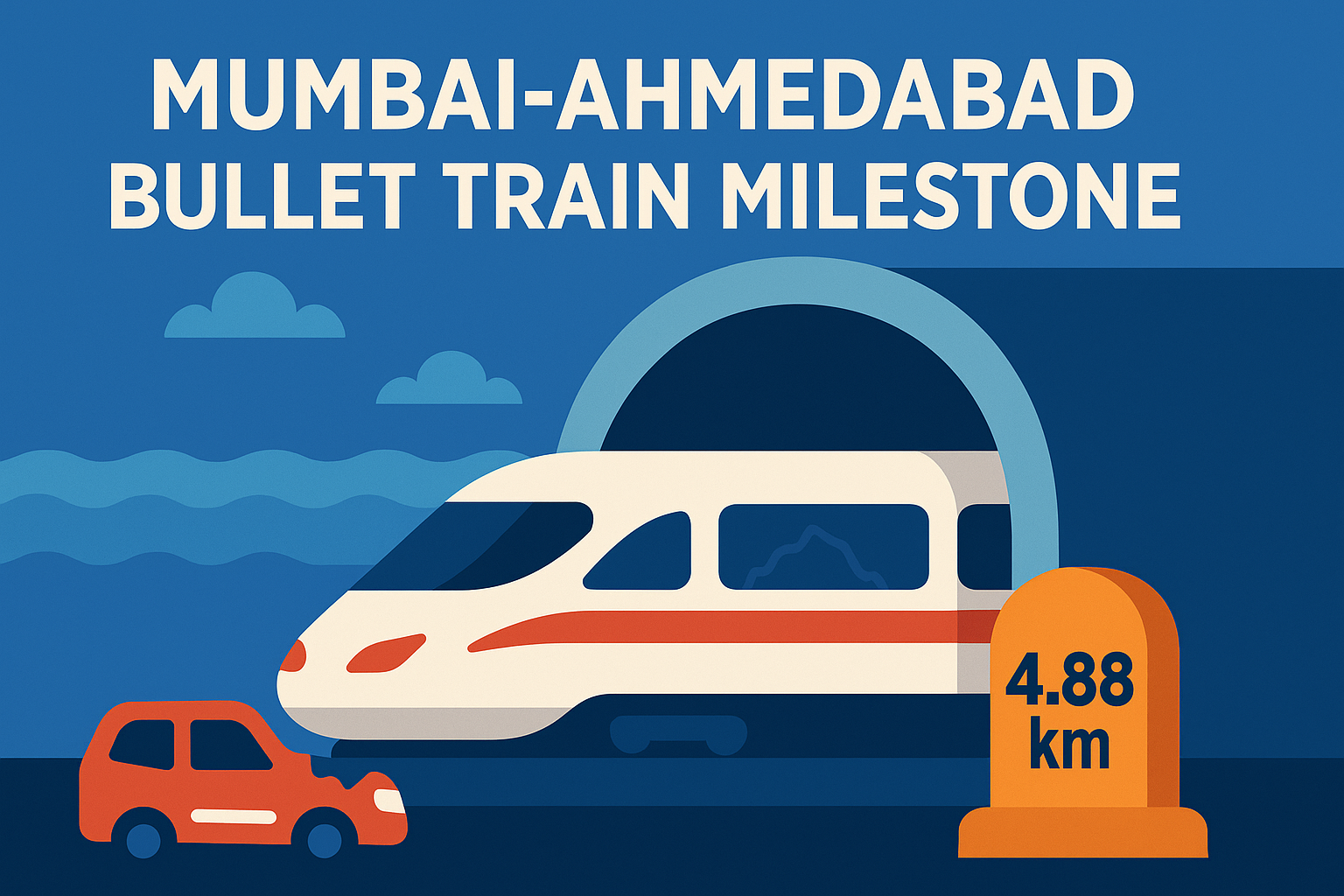
Mumbai-Ahmedabad Bullet Train Milestone: 4.88 km Tunnel Breakthrough Under Thane Creek Marks Engineering Feat
In a historic achievement for India’s first high-speed rail corridor, the Mumbai-Ahmedabad bullet train project has crossed a significant milestone with the successful completion of a 4.88 km tunnel breakthrough under Thane Creek. Executed using the New Austrian Tunnelling Method (NATM), this development marks a crucial step forward in the country’s ambitious 508 km long bullet train corridor, which is designed to connect Mumbai and Ahmedabad at speeds of up to 320 km/h.
Breakthrough Under Thane Creek
The newly achieved tunnel section, measuring 4.881 km in length, is part of the 21 km long underground stretch between Bandra Kurla Complex (BKC) and Shilphata. Notably, this includes a 7 km section beneath Thane Creek, one of the most geologically challenging parts of the project.
Tunnelling began in May 2024 from three separate faces, and on July 9, 2025, the project recorded its first major breakthrough of 2.7 km between the ADIT (Additionally Driven Intermediate Tunnel) and Savli shaft. With this latest development, engineers have completed a continuous tunnel stretch of nearly 5 km, connecting the Savli shaft to the Shilphata portal.
This section, built with a 12.6-meter internal width excavation, will eventually link with the viaduct portion of the Mumbai-Ahmedabad High-Speed Rail (MAHSR) project at Shilphata.
Overcoming Complex Geological Challenges
The Thane Creek tunnel breakthrough is more than just a length of concrete and steel—it represents the overcoming of one of the toughest engineering challenges in India’s infrastructure sector. Excavation involved advanced survey works, drilling, controlled blasting, and extensive support systems to manage geological complexities.
Safety was given paramount importance, with strict access restrictions to construction sites, controlled ventilation systems to pump fresh air for workers, and continuous monitoring to ensure a secure working environment. The successful completion validates the efficiency of NATM and the ability of Indian and international teams to handle such large-scale, complex infrastructure work.
What Lies Ahead: Final Construction Stages
With excavation works completed, the project now moves into its final stages of tunnel construction. This will include:
- Waterproofing and lining of tunnel interiors
- Installation of mechanical and electrical equipment
- Finishing works for long-term durability
The ADIT approach proved vital in speeding up progress by enabling simultaneous excavation from both Ghansoli and Shilphata sides. This multi-point working method is expected to be used further across remaining tunnel sections to keep the project timeline on track.
Project-Wide Progress Updates
While the Thane Creek breakthrough has grabbed headlines, other parts of the Mumbai-Ahmedabad bullet train corridor are also seeing steady advancement. According to project officials:
- Out of the 508 km route, 321 km of viaduct and 398 km of pier work have been completed.
- 17 river bridges and 9 steel bridges have been successfully built.
- More than 4 lakh noise barriers have been installed across 206 km to reduce sound impact on nearby communities.
- 206 km of track bed construction is already finished.
- Over 2000 overhead equipment (OHE) masts have been installed, covering nearly 48 km of the viaduct.
- Excavation work is in progress on seven mountain tunnels in the Palghar district.
- In Gujarat, superstructure work on all bullet train stations is at an advanced stage, while in Maharashtra, base slab casting has begun for the underground Mumbai station.
India’s First Bullet Train: A Vision in Motion
Once completed, the Mumbai-Ahmedabad bullet train will be a game-changer for India’s transport sector. Covering the 508 km stretch in just about two hours, compared to the current seven-hour road journey, the project promises not just speed but also sustainability, reduced congestion, and global-standard passenger comfort.
The recent tunnel breakthrough under Thane Creek is a strong signal that India’s first high-speed rail project is moving closer to reality. With each engineering milestone, the dream of India’s bullet train inches closer to its first run, redefining mobility and infrastructure benchmarks for the nation.





